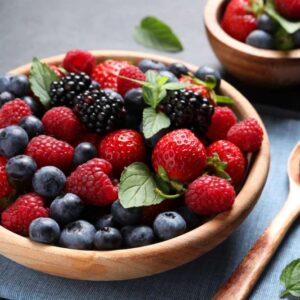
Eat Seasonally for Better Health While Helping Your Local Farmer
- Don’t waste your money on shipped and stored nutrient-less produce at the grocery store
- Forget that irradiated fruit and support your health with one easy share
- Two ways to find a consistent stream of seasonal produce
Dear Reader,
Produce is available just about everywhere these days. Supermarkets, big-box stores, and even gas stations carry anything from a red apple to a papaya year-round.
Want a pineapple in February? No problem, your local mega-supermarket will have at least a dozen on hand.
But since “Fresh is best” is the golden rule of produce… ever wonder how fresh that slightly shriveled and overly golden pineapple basking under the florescent lights of your local mega-mart actually is?
How many days, or more likely weeks, ago was it picked?
And how many planes, trains, boats, trucks, and hands did it pass through to get to your corner market?
Not to mention that even if you paid the extra to have an organic pineapple in February, how do you know it hasn’t make contact with pesticide-covered apricots? Or even one of those weird illness-causing parasites you’ve seen on the evening news?
When you think about it, there are lots of issues with this modern year-round produce availability.
There is a way to get local, seasonal, and many times organic or chemical-free produce, which I’ll get to in a bit.
But first, let’s take a peek at the problems with our current globally sourced produce supply.
That Not-So-Fresh Feeling in Your Produce Aisle
Perhaps the greatest concern about these globally traveled fruits and veggies is the lack of nutrients.
Since fruits and vegetables can be a great natural source of some vitamins and minerals when fresh, it seems counterintuitive to eat old produce for health purposes.
“If you harvest something early so that it can endure a long-distance shipping experience, it’s not going to have the full complement of nutrients it might have had,” reports Brian Halweil, author of Eat Here: Reclaiming Homegrown Pleasures in a Global Supermarket. 1
Halweil goes on to explain that fruits and vegetables traveling to faraway places often have added preservative like wax or are irradiated (shortly exposed to radiation) to preserve longevity and kill germs.
Currently, there is no science to show these practices cause health issues, but it seems like common sense to avoid produce subjected to such practices.
The other big issue with traveling produce is lack of flavor.
Once again, premature picking is the villain here. When fruits and vegetables are harvested too early, not only do their nutrients suffer, but their flavors do too.
Cookbook author and owner of French cooking school On Rue Tatin Susan Herrmann Loomis said this about the flavors of shipped produce:
“Foods lose flavor just as they lose moisture when they are held. Fresh, locally harvested foods have their full, whole flavors intact, which they release to us when we eat them. Foods that are chilled and shipped lose flavor at every step of the way — chilling cuts their flavor, transport cuts their flavor, being held in warehouses cuts their flavor.”
Additionally, when you buy from the grocery giants, you have no connection to your food.
While knowing your food source is a foreign idea for most of us these days, it can be comforting to know where your food is coming from.
Fortunately, most communities have a way for you to get fresh, seasonal, local, and typically chemical-free produce.
Sharing the Harvest
It’s called community-supported agriculture (CSA).
CSAs offer shares of a local farms’ harvest to consumers or “members.” These shares can be picked up at an agreed-upon location (typically a farmers market) or, in some cases, delivered to the member’s home or place of business.
These pickups or deliveries are typically once a week for the duration of the harvest. While harvest season varies for different parts of the country, it’s usually June–November (possibly a bit earlier or later if you live in a different climate).
The shares also come in varying sizes. A half-share works for single people or families of two, whereas a full share is better designed for three–four people. If you have a large family, you can buy multiple shares.
I was a member of a CSA last year. I was surprised at the wide variety of vegetables and fruits I would get in my share. I learned to cook new things I would have never bought on my own, like kohlrabi and French radishes.
While my CSA was very interactive with its members and provided recipes and storage suggestions with each share, you can easily find cooking ideas or ways to store your produce on the Internet.
Also, I often found myself with more than enough produce for the week, so I would freeze any leftovers. By the end of the season, I had a freezer full of vegetables, fruits, and herbs all ready to get me through the winter months — keeping me from having to rely on the grocery store!
But the best part of a CSA membership is the consistent source of nutrient-rich and flavorful foods that also support your local farmer and help the environment.
While there is no guarantee of specific produce in your shares, the farm will usually provide a harvest plan for the season.
Most CSAs I have come across are organic or chemical-free. Be sure to ask your farmer about their practices.
If you are interested in joining a CSA in your area, click here to access Local Harvest. This website will help you locate a CSA in your community and get you started on your path to local, nutrient-dense fruits and veggies!
If you can’t find a CSA in your area on Local Harvest, simply do an internet search for CSA’s in your area — that’s how I found my last one.
CSA signups have already begun in some communities, so it is important to get the ball rolling on finding a CSA that is right for you.
If you don’t think a CSA is a good fit for you, I recommend trying to buy produce from local farmers markets or vendors for the added nutrients and flavor.
If you have a CSA experience you want to share, write me! nmoore@lfb.org
Live well,

Natalie Moore
Managing editor, Living Well Daily
P.S. While seasonal produce is a better source of vitamins and minerals than globally sourced fruits and veggies, it is important to remember they are not a total source for some key nutrients — B-12, calcium, and iron to name a few. And as we discussed last week, certain vitamins are not easily absorbed from foods. Be sure you are getting these key nutrients from other foods sources or supplements.
Sources
[1] Benefits of Eating What’s in Season
Written By Natalie Moore
Natalie Moore is a dedicated health researcher with a passion for finding healthy, natural, and science-based solutions. After a decade of direct healthcare experience in western and natural medicine, she was involved in public health research before joining Living Well Daily.
View More Free Articles
Four Carbs that Could Add YEARS to Your Life
You’ve likely been avoiding carbs like the plague. Health gurus, fitness influencers, and diet books have convinced you that carbs are the enemy—that they spike your blood sugar, pack on pounds, and fast-track you to diabetes. So you’ve eliminated bread, sworn off pasta, and feel guilty just touching a piece of fruit. But what if...
Upgrade from Bananas and Apples to These Powerhouse Fruits
I’m often asked which fruits are the best. So, let’s talk about it. I’ll cut right to the chase: berries win this contest hands down. If you’re limiting your options to apples and bananas, you’re missing out on a universe of superior antioxidant power. Those everyday fruits are like bringing a knife to a gunfight...
The REAL Reason Americans are Getting “Fatter”
You’ve heard it a thousand times: “Americans are getting fatter because we’re lazy.” We sit at desks all day. We binge-watch Netflix instead of hitting the gym. We’ve traded physical labor for sedentary lifestyles. It’s a tidy explanation for why obesity has skyrocketed in developed countries. There’s just one problem—it’s completely wrong… A groundbreaking Duke...
Mailbag: Room Won't Stop Spinning? Do THIS First
“I’m dealing with vertigo issues, lightheadedness, and dizziness. As recently as this last Saturday I had multiple occurrences throughout the day. Is there anything I can do for this? I’m 69 and in good health. I work out 4 to 5 times a week.” —Spinning Hi Spinning, When patients approach me with similar complaints, I...
Hidden Number Secretly Sabotages Male Performance
Guys (and gals that love them), we should talk. You know how we’ve always been told that bedroom troubles are just part of getting older—that we just need to live with them? Well, it turns out that’s not true. Scientists recently wrapped up a six-year study that followed over 100 healthy men, and the findings...
Shocking Study Links Kids' Snacks to Dangerous Early Puberty
Kids are growing up in a world vastly different from the one we knew. Back in our day, if a child wanted something sweet, it was a piece of candy or a homemade cookie. Today’s kids are surrounded by products filled with artificial sweeteners that didn’t even exist when we were raising our own children....
Outdated Vitamin Guidelines Put Your Brain at Risk
If you’re like most people, you probably don’t think twice about vitamin B12—until your doctor mentions it during a routine blood test. But new research published in the Annals of Neurology suggests we need to pay closer attention to this crucial nutrient—especially as we age. Turns out, current guidelines for this essential nutrient might be...
The TRUTH About Supplement "Liver Dangers" REVEALED
There’s been a lot of buzz lately about liver damage from supplements—so, let’s talk about it. Reports of supplement-induced liver injuries have some folks wondering, “Could my natural remedy actually be harming me?” But before you toss all your supplements in the trash, let’s separate fact from fear—and talk about how to use supplements safely....
The 10,000 Steps LIE That's Ruining Your Health
I’ll be honest—I’m a little sick of the 10,000-steps theory. You know, the one that insists you need to take at least that many steps daily to stay healthy? You won’t believe where that claim originally came from. The 10,000-steps theory wasn’t handed down from the fitness gods on stone tablets. It originated from a...
“Brain Games” Failed You? Try THIS For Better Memory Instead
You know all those brain-training apps, supplements, and “miracle” memory-boosters that promise to keep your brain sharp as you age? Here’s the truth… There IS evidence they support brain health—and that’s why I’ll be the first to recommend them. But they aren’t the most powerful brain-boosting tool available to you. Another surprising solution has earned...









